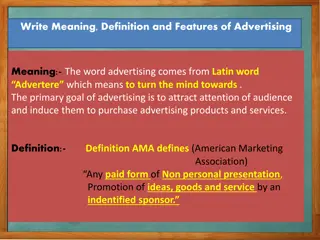Exploring the Impact of Advertising on Children
In today's society, children are constantly exposed to advertising through various media channels, influencing their perceptions and behaviors. This research delves into how children perceive and interact with advertisements, highlighting the importance of understanding the persuasive intent and potential bias present in marketing tactics targeting children. By examining the efficacy of different advertising techniques, such as the use of licensed characters and creating fun and engaging ads, this study sheds light on the complex relationship between advertising and children's behavior.
Download Presentation

Please find below an Image/Link to download the presentation.
The content on the website is provided AS IS for your information and personal use only. It may not be sold, licensed, or shared on other websites without obtaining consent from the author. Download presentation by click this link. If you encounter any issues during the download, it is possible that the publisher has removed the file from their server.
E N D
Presentation Transcript
Media and Children Ben Center Exploring the Relationship Between Advertising and Children
Intro We are surrounded by advertisements in our daily life. To a child this world full of advertisements could be overwhelming, confusing and even exciting.
Understanding Advertisements Identifying Ads Understanding the persuasive intent of advertising Knowing that advertisements can be bias and deceptive
Identifying Ads Research was done to determine when children could distinguish advertisements from TV programs. 70% of four year olds 90% of five year olds
Understanding Persuasive Intent Robinson and Rossiter conducted research trying to find what age children understand the persuasive intent of advertisements. 53% of first graders 87% of third graders 99% of fifth graders
Bias and Deception of Ads 50% of kindergarteners knew ads could be deceiving and bias 88% of third grade children knew this 97% of sixth grade children identified bias and deception
Developing Advertising Tactics Advertisers use this information to tailor their marketing strategy so they can reach their audience. A article titled Sweet Promises researchers identified marketing techniques used to engage children with advertisements in the food industry.
Marketing Techniques Third-party licensed characters Advertisers use a recognizable character to influence children Star Wars Kraft Mac and Cheese https://www.youtube.com/ watch?v=8TTRR23-Ex0
Marketing Techniques Continued Advertisers make their ads cool and fun Advertisers also animate their products to entertain children Sour Patch Kids https://www.youtube.com/ watch?v=wiRUI8u_CDU
Animation Continued Cinnamon Toast Crunch https://www.youtube.com/ watch?v=B8REd2LUZ4c
Animation Continued Goldfish https://www.youtube.com/ watch?v=eN1F7R1VJs0
Marketing Techniques Continued Brand Characters
Government Policies and Regulations Children s Food and Advertising Initiative (CFBAI) The Children s Online Privacy Protection Act The Children s Advertising Review Unit (CARU)
References Carlson, L., & Macklin, M. C. (1999). Advertising to Children : Concepts and Controversies. Thousand Oaks, Calif: SAGE Publications, Inc. Harris, J., Lodolce, M., Dembek, C., & Schwartz, M. (2015). Sweet promises: Candy advertising to children and implications for industry self- regulation. Appetite, 95, 585. Opree, S., Buijzen, M., Van Reijmersdal, E., & Valkenburg, P. (2014). Children s Advertising Exposure, Advertised Product Desire, and Materialism. Communication Research, 41(5), 717-735. Sener, A., Guven, S., & Boylu, A. (2010). Children and Advertising What Do They Think about Advertisements, How Are They Affected by Advertisements? (Children's Issues, Laws and Programs). New York: Nova Science , Incorporated.























